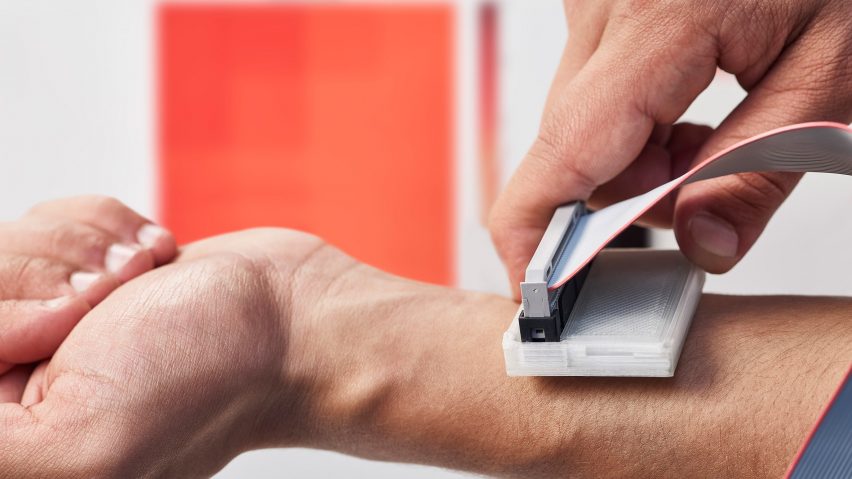For our review of 2017, architecture reporter India Block has selected the top 10 advances in technology that got us excited for the future this year, including a jet-propelled flying suit, revolutionary 3D printing technology and a non-invasive skin-cancer detector.
Hyperloop One's first full system test reached 190 miles per hour
We came one step closer to near-supersonic speed terrestrial transport this year. Hyperloop One trialled its passenger pods at the DevLoop test site in the Nevada desert – and it was a speedy success.
Using electromagnetic levitation, the carbon-fibre and aluminium passenger pods travelled through the 500-metre-long concrete vacuum tubes at 190 miles per hour, taking just five seconds.
Find out more more about Hyperloop One's first full system test ›
IKEA launches solar battery packs to rival Telsa's Powerwall
Swedish flat-pack furniture giant went IKEA toe-to-toe with Telsa this year, as it launched its latest domestic solar panel offering, which it claims could cut homeowners' electricity bills by 70 per cent.
Its new battery packs allow owners to store power from solar panels, so they can use the power generated by the sun, rather than having to rely on the energy grid.
Find out more about IKEA launches solar battery packs ›
MIT Self-Assembly Lab's Rapid Liquid Printing technology can "print furniture in minutes"
Researchers at Massachusetts Institute of Technology developed a revolutionary type of 3D printing technology in 2017, which can print large-scale structures, such as furniture, in record time.
Rapid Liquid Printing works by extruding material from a computer-controlled nozzle into gel. Rather than traditional 3D printing, which relies on building up layers, the robotic arm can print freely within the confines of the gel tank.
Find out more about Rapid Liquid Printing technology ›
The world's first commercial carbon-capture plant opens in Switzerland
Switzerland saw the opening of the world's first carbon-capture plant, an industrial air-capture device that sucks carbon dioxide (CO2) out of the atmosphere then resells it as a raw material.
Climework's plant can filter out up to 900 tonnes of CO2 a year, which can then be supplied as a raw material to customers such as a nearby vegetable farm, which uses it as fertiliser.
Find out more about the world's first commercial carbon-capture plant ›
Google's new headphones double as a personal translator
This year saw Google launch its first pair of headphones, which doubles as an in-ear translator. Pixel Buds come with a voice-assistant feature that can translate whole conversations in 40 languages in real-time.
Users simply hold down a button on the right earbud to activate the voice assistant. Connected to a Pixel smartphone, phrases are translated and played out loud through the phone's speakers. Replies are then translated and played back through the headphones.
Find out more about Google's new headphones ›
Students from Canadian university develop device that detects skin cancer
A group of engineering students from McMaster University in Canada won the James Dyson Award in 2017, with a device that can detect skin cancer without the need for a biopsy.
The Skan is non-invasive device that, when placed on top of the skin, can detect melanomas. Using a series of thermistors, it cools the area, then monitors how long it takes for the skin to regain its normal temperature, revealing cancerous cells, which have a higher metabolic rate.
Find out more about the device that detects skin cancer ›
Iron Man-esque flying suit sets world speed record
Ex-Royal Marine Reservist and inventor Richard Browning whizzed straight out of a superhero movie, setting a new world speed record with his flying suit.
Wearing his body-controlled jet-engine-propelled suit he reached a speed of 32.02 miles per hour, flying over a lake in England.
Find out more about the flying suit ›
Apple announces iPhone X with Face ID technology
Apple dropped its latest offering, the iPhone X, complete with new facial recognition technology.
In what CEO Tim Cook called "the biggest leap forward since the original iPhone", the smartphone uses a "true-depth" camera system to create a mathematical model of a user's face to allow it to recognise its owner.
Find out more about Apple's Face ID technology ›
Mayfield Robotics reveals "insanely cute" home robot
Domestic robots got an adorable new face in the form of Kuri – a 50-centimetre-high robot with a stout body, round head and two huge eyes, which responds to voice commands with expressions and head movements.
Developed by Californian start-up Mayfield Robotics, Kuri can navigate around obstacles, connect to Wi-Fi, play music through in-built speakers, and monitor the home whilst its owners are away.
Find out more about the "insanely cute" home robot ›
Dubai begins flying world's first passenger drone
The world's first passenger drone began running test flights over Dubai this year, including a maiden voyage over the Burj al-Arab skyscraper hotel.
The Ehang 184 can carry one passenger weighing up to 100 kilograms and remain airborne for 30 minutes on one charge. Destinations are entered via a touchscreen, then the vehicle is flown via auto-pilot, so passengers don't need a pilot's license to fly.
Find out more about the world's first passenger drone ›

